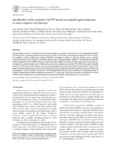Por favor, use este identificador para citar o enlazar este ítem:
http://www.alice.cnptia.embrapa.br/alice/handle/doc/986708Registro completo de metadatos
| Campo DC | Valor | Lengua/Idioma |
|---|---|---|
| dc.contributor.author | BÜCKER NETO, L. | pt_BR |
| dc.contributor.author | OLIVEIRA, R. R. de | pt_BR |
| dc.contributor.author | WIEBKE-STROHM, B. | pt_BR |
| dc.contributor.author | BENCKE, M. | pt_BR |
| dc.contributor.author | WEBER, R. L. M. | pt_BR |
| dc.contributor.author | CABREIRA, C. | pt_BR |
| dc.contributor.author | ABDELNOOR, R. V. | pt_BR |
| dc.contributor.author | MARCELINO-GUIMARÃES, F. C. | pt_BR |
| dc.contributor.author | ZANETTINI, M. H. D. | pt_BR |
| dc.contributor.author | PASSAGLIA, L. M. P. | pt_BR |
| dc.date.accessioned | 2014-05-21T11:11:11Z | pt_BR |
| dc.date.available | 2014-05-21T11:11:11Z | pt_BR |
| dc.date.created | 2014-05-21 | pt_BR |
| dc.date.issued | 2013 | pt_BR |
| dc.identifier.citation | Genetics and Molecular Biology, Ribeirão Preto, v. 36, n. 2, p. 214-224, 2013. | pt_BR |
| dc.identifier.issn | 1415-4757 | pt_BR |
| dc.identifier.uri | http://www.alice.cnptia.embrapa.br/alice/handle/doc/986708 | pt_BR |
| dc.description | Soybean [Glycine max (L.) Merril], one of the most important crop species in the world, is very susceptible to abiotic and biotic stress. Soybean plants have developed a variety of molecular mechanisms that help them survive stressful conditions. Hybrid proline-rich proteins (HyPRPs) constitute a family of cell-wall proteins with a variable N-terminal domain and conserved C-terminal domain that is phylogenetically related to non-specific lipid transfer proteins. Members of the HyPRP family are involved in basic cellular processes and their expression and activity are modulated by environmental factors. In this study, microarray analysis and real time RT-qPCR were used to identify putative HyPRP genes in the soybean genome and to assess their expression in different plant tissues. Some of the genes were also analyzed by time-course real time RT-qPCR in response to infection by Phakopsora pachyrhizi, the causal agent of Asian soybean rust disease. Our findings indicate that the time of induction of a defense pathway is crucial in triggering the soybean resistance response to P. pachyrhizi. This is the first study to identify the soybean HyPRP group B family and to analyze disease-responsive GmHyPRP during infection by P. pachyrhizi. | pt_BR |
| dc.language.iso | eng | eng |
| dc.rights | openAccess | eng |
| dc.subject | Ferrugem asiática da soja | pt_BR |
| dc.title | Identification of the soybean HyPRP family and specific gene response to Asian soybean rust disease. | pt_BR |
| dc.type | Artigo de periódico | pt_BR |
| dc.date.updated | 2014-05-22T11:11:11Z | pt_BR |
| riaa.ainfo.id | 986708 | pt_BR |
| riaa.ainfo.lastupdate | 2014-05-22 | pt_BR |
| dc.identifier.doi | 10.1590/S1415-47572013005000017 | pt_BR |
| dc.contributor.institution | LAURO BÜCKER NETO, UFRGS; RAFAEL RODRIGUES DE OLIVEIRA, UFRGS; BEATRIZ WIEBKE-STROHM, UFRGS; MARTA BENCKE, UFRGS; RICARDO LUÍS MAYER WEBER, UFRGS; CAROLINE CABREIRA, UFRGS; RICARDO VILELA ABDELNOOR, CNPSO; FRANCISMAR CORREA MARCELINO-GUIMARÃES, CNPSO; MARIA HELENA BODANESE ZANETTINI, UFRGS; LUCIANE MARIA PEREIRA PASSAGLIA, UFRGS. | pt_BR |
| Aparece en las colecciones: | Artigo em periódico indexado (CNPSO)  | |
Ficheros en este ítem:
| Fichero | Descripción | Tamaño | Formato | |
|---|---|---|---|---|
| IdentificationofthesoybeanHyPRPfamilyandspecificgeneresponsetoAsiansoybeanrustdisease.pdf | 1,56 MB | Adobe PDF |  Visualizar/Abrir |









